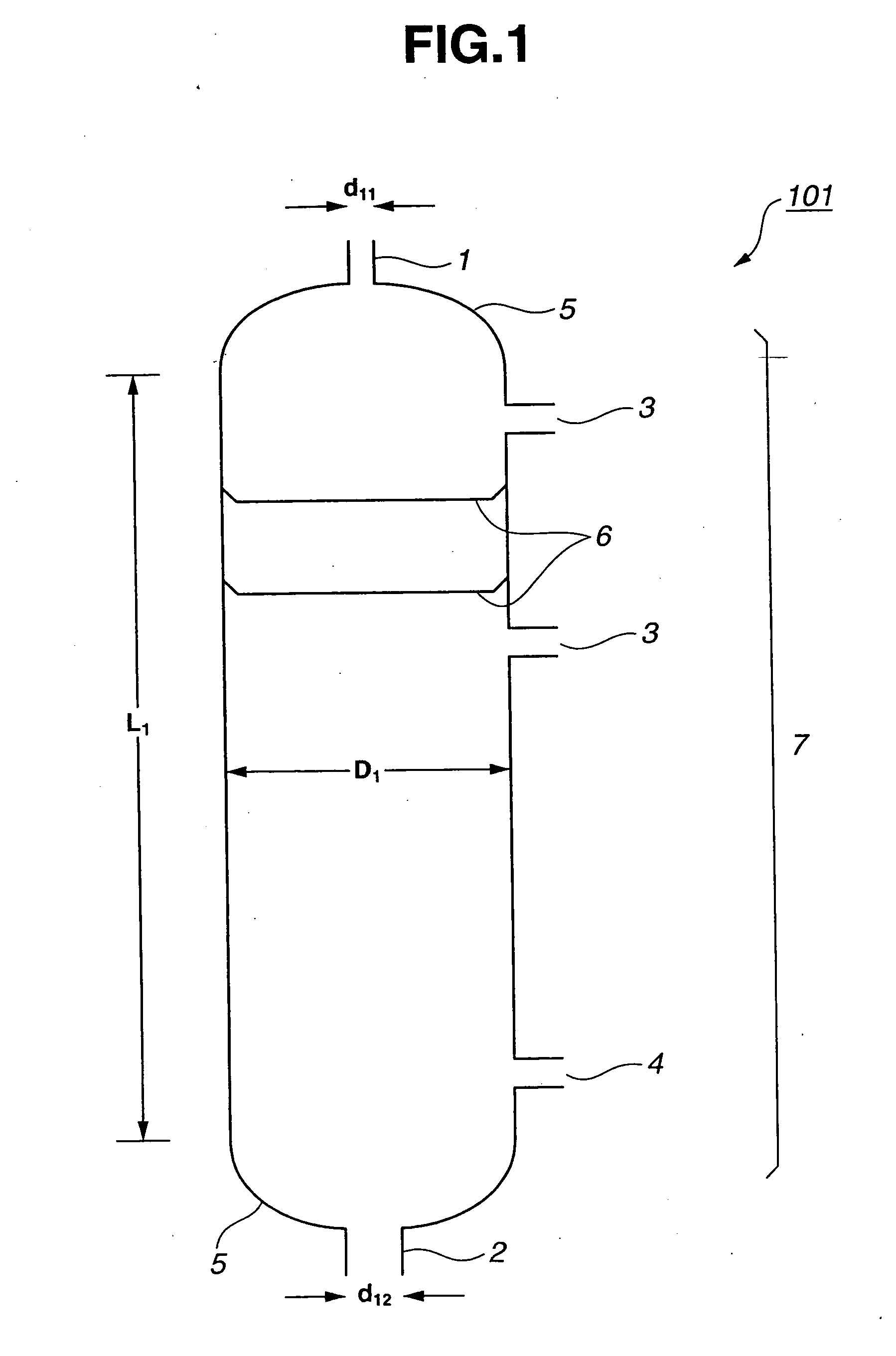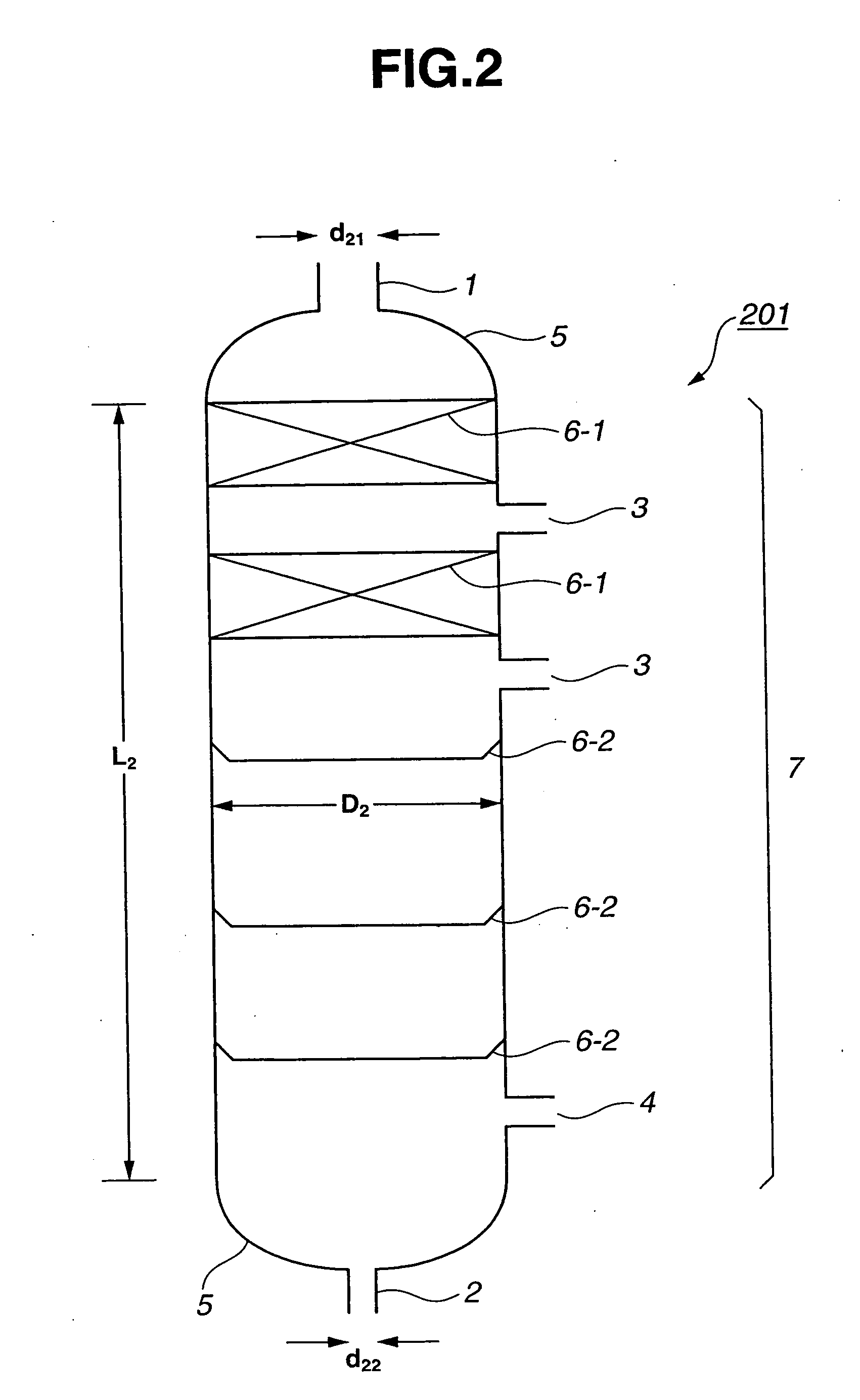Process for industrial production of an aromatic carbonate
a technology of industrial production and aromatic carbonate, which is applied in the direction of separation process, carbonic/haloformic acid esters purification/separation, sustainable manufacturing/processing, etc., to achieve high selectivity and high purity
- Summary
- Abstract
- Description
- Claims
- Application Information
AI Technical Summary
Benefits of technology
Problems solved by technology
Method used
Image
Examples
example 1
101>
[0162] A continuous multi-stage distillation column as shown in FIG. 1 having L1=3300 cm, D1=500 cm, L1 / D1=6.6, n1=80, D1 / d11=17, and D1 / d12=9 was used. In this Example, the sieve tray having the cross-sectional area per hole being approximately 1.5 cm2 and the number of holes being approximately 250 / m2 were used as the internal.
201>
[0163] A continuous multi-stage distillation column as shown in FIG. 2 having L2=3100 cm, D2=500 cm, L2 / D2=6.2, n2=30, D2 / d21=3.85, and D2 / d22=11.1 was used. In this Example, as the internal, two sets of Mellapak (total number of stages 11) were installed in the upper portion, and the sieve tray having the cross-sectional area per hole being approximately 1.3 cm2 and the number of holes being approximately 250 / m2 were used in the lower portion.
[0164] Diphenyl carbonate was produced by carrying out reactive distillation using a apparatus in which the first continuous multi-stage distillation column 101 and the second continuous multi-stage distillat...
example 2
[0169] Reactive distillation was carried out under the following conditions using the same apparatus as in Example 1.
[0170] A starting material 1 containing phenol and dimethyl carbonate in a weight ratio of phenol / dimethyl carbonate=1.1 was introduced continuously in a liquid form at a flow rate of 40 ton / hr from the upper inlet 11 of the first continuous multi-stage distillation column 101. On the other hand, a starting material 2 containing dimethyl carbonate and phenol in a weight ratio of dimethyl carbonate / phenol=3.9 was introduced continuously in a gaseous form at a flow rate of 43 ton / hr from the lower inlet 12 of the first continuous multi-stage distillation column 101. The molar ratio for the starting materials introduced into the first continuous multi-stage distillation column 101 was dimethyl carbonate / phenol=1.87. The starting materials substantially did not contain halogens (outside the detection limit for the ion chromatography, i.e. 1 ppb or less). Pb(OPh)2 as a ca...
example 3
[0175] Reactive distillation was carried out under the following conditions using the same apparatus as in Example 1 except that the cross-sectional area per hole of each of the sieve trays in the second continuous multi-stage distillation column 201 was made to be approximately 1.8 cm2.
[0176] A starting material 1 containing phenol and dimethyl carbonate in a weight ratio of phenol / dimethyl carbonate=1.7 was introduced continuously in a liquid form at a flow rate of 86 ton / hr from the upper inlet 11 of the first continuous multi-stage distillation column 101. On the other hand, a starting material 2 containing dimethyl carbonate and phenol in a weight ratio of dimethyl carbonate / phenol=3.5 was introduced continuously in a gaseous form at a flow rate of 90 ton / hr from the lower inlet 12 of the first continuous multi-stage distillation column 101. The molar ratio for the starting materials introduced into the first continuous multi-stage distillation column 101 was dimethyl carbonat...
PUM
| Property | Measurement | Unit |
|---|---|---|
| cross-sectional area | aaaaa | aaaaa |
| area | aaaaa | aaaaa |
| area | aaaaa | aaaaa |
Abstract
Description
Claims
Application Information
 Login to View More
Login to View More - R&D
- Intellectual Property
- Life Sciences
- Materials
- Tech Scout
- Unparalleled Data Quality
- Higher Quality Content
- 60% Fewer Hallucinations
Browse by: Latest US Patents, China's latest patents, Technical Efficacy Thesaurus, Application Domain, Technology Topic, Popular Technical Reports.
© 2025 PatSnap. All rights reserved.Legal|Privacy policy|Modern Slavery Act Transparency Statement|Sitemap|About US| Contact US: help@patsnap.com



